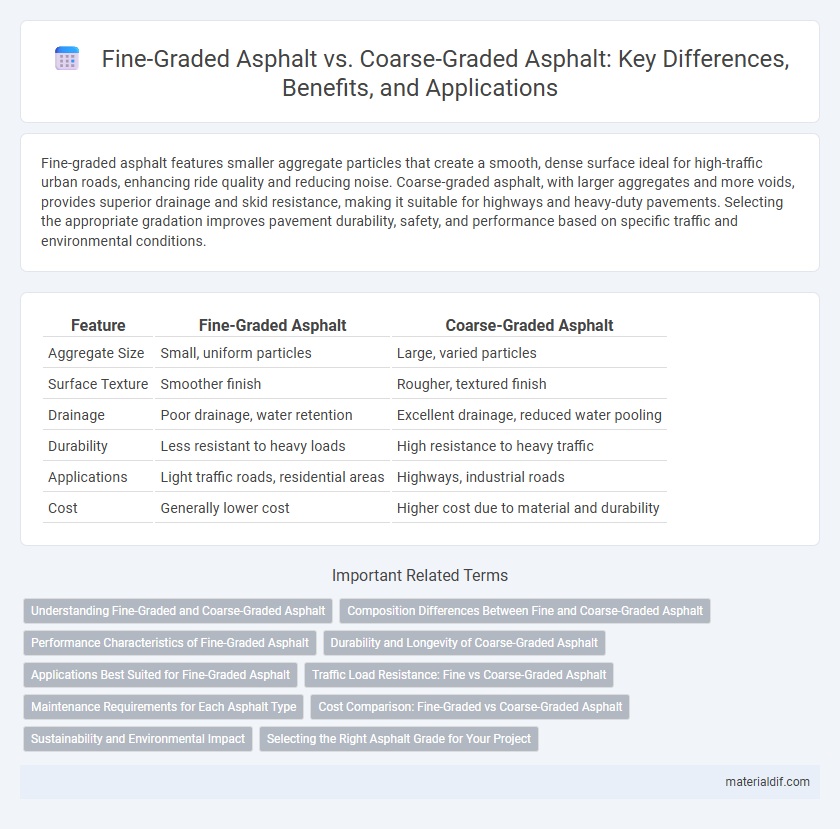Fine-graded asphalt features smaller aggregate particles that create a smooth, dense surface ideal for high-traffic urban roads, enhancing ride quality and reducing noise. Coarse-graded asphalt, with larger aggregates and more voids, provides superior drainage and skid resistance, making it suitable for highways and heavy-duty pavements. Selecting the appropriate gradation improves pavement durability, safety, and performance based on specific traffic and environmental conditions.
Table of Comparison
| Feature | Fine-Graded Asphalt | Coarse-Graded Asphalt |
|---|---|---|
| Aggregate Size | Small, uniform particles | Large, varied particles |
| Surface Texture | Smoother finish | Rougher, textured finish |
| Drainage | Poor drainage, water retention | Excellent drainage, reduced water pooling |
| Durability | Less resistant to heavy loads | High resistance to heavy traffic |
| Applications | Light traffic roads, residential areas | Highways, industrial roads |
| Cost | Generally lower cost | Higher cost due to material and durability |
Understanding Fine-Graded and Coarse-Graded Asphalt
Fine-graded asphalt consists of smaller, uniformly sized aggregates that create a dense and smooth surface ideal for low-traffic areas and provides improved waterproofing. Coarse-graded asphalt contains larger, irregularly sized aggregates, enhancing load-bearing capacity and skid resistance, making it suitable for highways and heavy-duty pavements. Selecting between fine-graded and coarse-graded asphalt depends on specific performance needs such as durability, traffic volume, and surface texture requirements.
Composition Differences Between Fine and Coarse-Graded Asphalt
Fine-graded asphalt consists predominantly of smaller aggregate particles, typically below 4.75 mm, resulting in a denser mix that enhances surface smoothness and reduces permeability. Coarse-graded asphalt incorporates larger aggregate sizes, often ranging from 9.5 mm to 25 mm, which improves load distribution and offers superior resistance to deformation under heavy traffic. The distinct particle size distribution in fine and coarse-graded asphalt directly influences the pavement's mechanical properties, durability, and suitability for various road construction applications.
Performance Characteristics of Fine-Graded Asphalt
Fine-graded asphalt demonstrates superior compaction abilities and improved surface smoothness due to its higher proportion of smaller aggregate particles, enhancing skid resistance and reducing noise levels on roadways. The dense matrix of fine-graded asphalt contributes to greater resistance against water infiltration and rutting, extending pavement durability in high-traffic urban areas. Optimal performance is achieved in finely graded mixes through precise grading that balances void content and binder distribution, resulting in enhanced load-bearing capacity and flexibility under varying temperatures.
Durability and Longevity of Coarse-Graded Asphalt
Coarse-graded asphalt exhibits superior durability and longevity compared to fine-graded asphalt due to its larger aggregate particles, which enhance load distribution and resistance to deformation. This type of asphalt is less prone to rutting and cracking, making it ideal for high-traffic roads and heavy load conditions. Its open-graded structure also improves drainage, reducing water-related damage and extending pavement lifespan significantly.
Applications Best Suited for Fine-Graded Asphalt
Fine-graded asphalt, characterized by its higher proportion of smaller aggregates, offers superior compaction and smooth surface texture, making it ideal for applications such as urban streets, parking lots, and residential roads where ride quality and noise reduction are priorities. Its dense and uniform structure enhances fatigue resistance and water impermeability, benefiting pavements subject to moderate traffic loads and frequent stop-and-go conditions. Fine-graded asphalt is also preferred for overlay treatments and surface courses to improve durability and extend pavement life in environments requiring enhanced skid resistance and aesthetic finish.
Traffic Load Resistance: Fine vs Coarse-Graded Asphalt
Fine-graded asphalt offers enhanced resistance to low traffic loads due to its dense matrix and smoother surface texture, reducing deformation under lighter vehicles. Coarse-graded asphalt, characterized by larger aggregate sizes and higher air voids, provides superior durability and load distribution for heavy traffic conditions, preventing rutting and fatigue. Selecting the appropriate gradation depends on expected traffic intensity, with fine-graded mixes favored for light urban roads and coarse-graded asphalt ideal for highways and heavy-duty pavements.
Maintenance Requirements for Each Asphalt Type
Fine-graded asphalt typically requires more frequent maintenance due to its smoother surface being more susceptible to wear and tear, such as cracks and rutting, especially under heavy traffic conditions. Coarse-graded asphalt, with its larger aggregate particles, offers better resistance to deformation and typically demands less frequent upkeep but may experience issues like surface roughness and stone loss over time. Proper selection based on traffic load and environmental conditions is crucial to optimize maintenance intervals and pavement longevity.
Cost Comparison: Fine-Graded vs Coarse-Graded Asphalt
Fine-graded asphalt typically incurs higher costs due to the increased use of filler materials and finer aggregates, which improve surface smoothness and durability but require more precise manufacturing. Coarse-graded asphalt is generally less expensive, utilizing larger aggregates that reduce material costs while providing better structural stability for heavy traffic loads. Cost efficiency depends on project specifications, with fine-graded asphalt favored for high-performance urban roads and coarse-graded asphalt preferred for highways and industrial applications.
Sustainability and Environmental Impact
Fine-graded asphalt offers improved compactness and reduced permeability, leading to extended pavement life and decreased maintenance, which minimizes resource consumption and environmental disturbance. Coarse-graded asphalt, while providing better drainage and resistance to rutting, may require more frequent repairs, increasing carbon emissions and material use over time. Selecting fine-graded asphalt contributes to sustainability goals by lowering lifecycle environmental impacts through enhanced durability and reduced energy demand in production and upkeep.
Selecting the Right Asphalt Grade for Your Project
Selecting the right asphalt grade hinges on project requirements, with fine-graded asphalt ideal for smooth surfaces and high-traffic areas due to its densely packed aggregates ensuring durability and reduced permeability. Coarse-graded asphalt suits heavy-duty applications, offering superior load distribution and resistance to rutting through larger aggregate sizes and increased air voids. Understanding traffic levels, climatic conditions, and structural demands guides the optimal choice between fine-graded and coarse-graded asphalt for longevity and performance.
Fine-Graded Asphalt vs Coarse-Graded Asphalt Infographic

 materialdif.com
materialdif.com